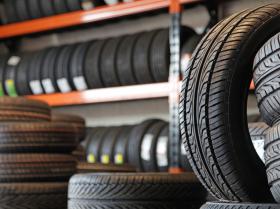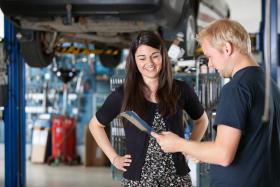Posted on 7/7/2017

How do you know if you need new tires? Tire wear depends on several factors, including your driving style and tire maintenance habits. Wrong size load and speed rating can void your warranty. But one sure way to know when to replace your tires is when treadwear indicators appear. A tire's built-in treadwear indicators are "wear bars" that look like narrow strips of smooth rubber across the tread and appear when it's time to replace the tire. You also need a new tire if: You can see three or more treadwear indicators around the tire Cord or fabric is showing through the rubber The tread or sidewall is cracked, cut or snagged deep enough to show cord or fabric The tire has a bulge or split The tire has a puncture, cut, or other damage that can't be repaired correctly Tire Pressure Maximize your tires' performance and durability by monitoring and maintaining correct air pressure. Air is ... read more
Posted on 7/5/2017

Within the internal combustion engine, the compression ratio, as it’s known, is the piston’s movement as it squeezes the fuel/air mixture in the cylinder. BG Products know that sadly loss of compression over time is inevitable. So it's a good thing BG's got a product to restore and maintain peak compression! Adding BG EPR to the engine and letting it tick over for at least 15 minutes restores compression by dissolving the deposits that clog rings and seals. Peak compression is a must Most technicians know that peak compression in an engine is necessary to allow an engine to extract the most energy from the fuel/air mixture. An engine’s proper compression ratio allows the right amount of oxygen and fuel molecules into a reduced space (the cylinder) along with heat caused by compression. A given petrol engine’s compression ratio example can be approximately 9:1, which means 9 units of air into the space of 1 unit. All of these elements working together resul ... read more
Posted on 7/2/2017

As gas prices continue to drop, motorists should take advantage of their savings at the pump and invest it back into their vehicles. By spending a little now to increase fuel efficiency, drivers can multiply fuel savings and save more money at the pump. The national average of the cost of a gallon of gas has been above $3 since 2010 but is expected to dip below that mark this year, according to a recent forecast by energy information service GasBuddy.com. A small investment in simple and inexpensive auto care will add up to better fuel economy and even more savings. The non-profit Car Care Council encourages motorists to be car care aware and perform simple steps to improve fuel efficiency and save money. Engine Performance: Keep your car properly tuned to improve gas mileage by an average of 4 percent. Tire Pressure: Keep tires properly inflated and improve gas mileage by up to 3.3 percent. Motor Oil: Imp ... read more
Posted on 6/30/2017
You wouldn't head out into cold weather without bundling up. Your vehicle faces similar challenges as temperatures drop. The bottom line: it needs a little extra care as the mercury plummets. A little preparation before winter sets in may help prevent major headaches later. What You Can Do Make sure you have a heavy-duty ice scraper and snow brush in your vehicle. Cold weather reduces tire pressure, so check tire pressure often. See your owner's manual for directions and details. In severe winter temperatures, you may have to change the grade of your engine oil. Check your vehicle's owner's manual for the viscosity grade recommended for your vehicle's engine. Check your wiper blades. Cold temperatures can make blades brittle, and ice on the windshield can cause nicks in the blades, decreasing performance. If you're planning a trip, take a blanket, extra-warm clothing, a collapsible shovel, a bag of road salt and an extra bottle of windsh ... read more
Posted on 6/28/2017
Your tires support the weight of your vehicle, right? Well they don't! It's the air pressure inside them that actually supports the weight. Maintaining sufficient air pressure is required if your tires are to provide all of the handling, traction and durability of which they are capable. However, you can't set tire pressure...and then forget about it! Tire pressure has to be checked periodically to assure that the influences of time, changes in ambient temperatures or a small tread puncture have not caused it to change. The tire pressure recommended in your vehicle's owner's manual or tire information placard is the vehicle's recommended cold tire inflation pressure. This means that it should be checked in the morning before you drive more than a few miles, or before rising ambient temperatures or the sun's radiant heat affects it. Since air is a gas, it expands when heated and contracts when cooled. In most parts of North America, this makes fall and early winter months th ... read more
Posted on 6/25/2017

When going green, everything is taken apart, cleaned, fixed, and put back together. The total opposite of a junk yard, where engines and their parts remain anonymous when it comes to their history. Not only is going green great for the environment, but great for you and your wallet both! For example, rather than buying a new car with a down payment; use that money to put towards going green today! You can't help it, serious engine troubles are going to come... One way, or another. We want you to be completely prepared for when the time comes! This is why we recommend "Going green". It repowers the vehicle you already own, it extends the life and reduces the impact on the environment an absurd amount! When going green, everything is taken apart, cleaned, fixed, and put back together. The total opposite of a junk yard, where engines and their parts remain anonymous when it comes to their history. Not only is going green great for the environment, but great for you and you ... read more
Posted on 6/22/2017

We would like to remind motorists that routine brake inspections are completely necessary to adhere to safe driving and maintaining your vehicle. “When it comes to vehicle safety, the brake system is at the top of the list, so have your brakes checked by an auto service professional at least once a year,” said Rich White, executive director, Car Care Council. “Knowing the key warning signs that your brakes may need maintenance will go a long way toward keeping you and others safe on the road.”
There are seven specific signs to know your brakes should be checked and serviced: Pulling:vehicle pulls to one side while braking. Low Pedal:brake pedal nearly touches the floor before engaging. Grabbing:brakes grab at the slightest touch to the pedal. Vibration: brake pedal vibrates or pulses, even under normal braking conditions. Noise:screeching, grinding or clicking ... read more
Posted on 6/22/2017

Nobody truly yearns to be in the heat constantly, occasionally it's nice to roll down the windows and cruise; but air conditioning was invented for a reason, so why let it malfunction? We recommend checking your vehicle’s A/C annually will help you keep your cool when temperatures soar.
“Getting stuck in traffic is stressful enough, but getting stuck in traffic during the heat of summer without a functioning A/C is the pits,” said Rich White, executive director, Car Care Council. “It is important to always have the A/C system properly maintained to keep it in tip-top shape and avoid costly repairs down the road.”
A vehicle’s heating, ventilating and air conditioning system (HVAC) keeps the interior cabin comfortable in any season by providing the right temperature and humidity level. A thorough inspection should be performed annually and a typical A/C service consists of the following steps: A service technician checks pressures to test operation, refrigera ... read more